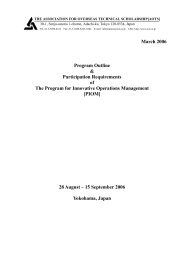Analysis of the Operation and Financial Condition of the Enterprise
Analysis of the Operation and Financial Condition of the Enterprise
Analysis of the Operation and Financial Condition of the Enterprise
Create successful ePaper yourself
Turn your PDF publications into a flip-book with our unique Google optimized e-Paper software.
<strong>Analysis</strong> <strong>of</strong> <strong>the</strong> <strong>Operation</strong> <strong>and</strong> <strong>Financial</strong> <strong>Condition</strong> <strong>of</strong> <strong>the</strong> <strong>Enterprise</strong><strong>Financial</strong> position <strong>of</strong> an enterprise is <strong>of</strong>ten dependent on how optimal <strong>the</strong> relation isbetween <strong>the</strong> shareholders’ equity <strong>and</strong> <strong>the</strong> capital borrowed. Development <strong>of</strong> an appropriatefinancing strategy helps enterprises to increase <strong>the</strong> efficiency <strong>of</strong> <strong>the</strong>ir operations.Consequently, measures <strong>of</strong> <strong>the</strong> capital structure are applied in financial analysis.These measures describe <strong>the</strong> level <strong>of</strong> protecting <strong>the</strong> interests <strong>of</strong> creditors <strong>and</strong> investors,allow identifying <strong>the</strong> relations with <strong>the</strong> shareholders’ equity or <strong>the</strong> total amount <strong>of</strong> assets,evaluation <strong>of</strong> <strong>the</strong> ability <strong>of</strong> an enterprise to increase <strong>the</strong> amount <strong>of</strong> liabilities <strong>and</strong> <strong>the</strong> ability<strong>of</strong> an enterprise to pay for its debts when <strong>the</strong>y fall due. The capital structure or solvencyratios are especially significant to creditors in order to assess <strong>the</strong> borrowing capacity <strong>of</strong> <strong>the</strong>enterprise.Percentage <strong>of</strong> shareholders’ equity from total capital structure is described byownership ratio or financial independence ratio <strong>and</strong> it can be expressed as <strong>the</strong> ratiobetween <strong>the</strong> interests <strong>of</strong> <strong>the</strong> owners <strong>and</strong> those <strong>of</strong> <strong>the</strong> creditors. The ratio is calculated asfollows:Equity capitalOwnership ratio = Total assets(4.7.)Capital is <strong>the</strong> assets required for <strong>the</strong> business operations <strong>of</strong> an enterprise that arereflected in <strong>the</strong> liabilities <strong>of</strong> <strong>the</strong> balance sheet.The ownership ratio describes <strong>the</strong> financial stability. It is considered in <strong>the</strong>practice <strong>of</strong> <strong>the</strong> western world that this ratio should be sufficiently high, that is a feature <strong>of</strong> astrong structure <strong>of</strong> <strong>the</strong> financial assets <strong>of</strong> an enterprise. Creditors prefer such a structureupon taking <strong>the</strong>ir decisions for issuing <strong>of</strong> a loan to <strong>the</strong> enterprise. If <strong>the</strong> percentage <strong>of</strong> loanassets is not high, <strong>the</strong>re is a leverage provided against losses during <strong>the</strong> periods <strong>of</strong>diminished operating activity as well as for receipt <strong>of</strong> a loan. It is assumed that <strong>the</strong> ratioshould be approximately at <strong>the</strong> level <strong>of</strong> 60% both from <strong>the</strong> point <strong>of</strong> view <strong>of</strong> creditors <strong>and</strong>investors. If <strong>the</strong> ratio is sufficiently high, issuance <strong>of</strong> a loan to an enterprise may beconsidered.Low level <strong>of</strong> this ratio indicates that <strong>the</strong>re should be a high amount <strong>of</strong> % payableon <strong>the</strong> loans, <strong>and</strong> <strong>the</strong> enterprise may lose possibilities <strong>of</strong> receiving fur<strong>the</strong>r loans; this meansthat <strong>the</strong> amount <strong>of</strong> liabilities should be decreased or else it is necessary to receive anadditional long-term loan in order to repay <strong>the</strong> short-term debts for which <strong>the</strong> repaymentdate is approaching.One <strong>of</strong> <strong>the</strong> most <strong>of</strong>ten used measures in this group is <strong>the</strong> percentage <strong>of</strong> <strong>the</strong> capitalborrowed in <strong>the</strong> balance sheet (<strong>the</strong> debt ratio); this is defined as <strong>the</strong> relationship betweentotal debts <strong>and</strong> total assets.Percentage <strong>of</strong> debt in <strong>the</strong>balance sheet (Debt ratio)=Total liabilitiesTotal assets(4.8.)The percentage <strong>of</strong> debts in <strong>the</strong> balance sheet describes <strong>the</strong> financial dependence<strong>of</strong> an enterprise on external loans. The higher it is, <strong>the</strong> more <strong>the</strong> enterprise is in debt, <strong>and</strong><strong>the</strong> more risky is <strong>the</strong> situation that may lead to bankruptcy.73
















